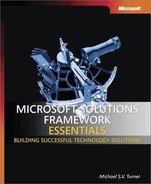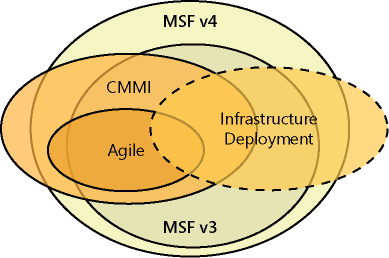- Microsoft® Solutions Framework Essentials: Building Successful Technology Solutions
- SPECIAL OFFER: Upgrade this ebook with O’Reilly
- Acknowledgments
- Introduction
- I. Solution Delivery Fundamentals
- 1. What Is MSF and Is It Right for You?
- 2. Understanding Solution Delivery Environments
- 3. Foundational Principles, Mindsets, and Proven Practices
- Foundational Principles
- Mindsets
- Proven Practices
- Summary
- 4. Building an MSF Team
- MSF Team Model: Team of Advocates
- Team of Advocates
- Quality Goals: Team of Quality Champions
- Satisfied Stakeholders
- Coordinate Identification and Optimization of Project Constraints
- Define Solution Within Project Constraints
- Deliver Solution Within Project Constraints
- Design Solution Within Project Constraints
- Build Solution to Specification
- Confirm All Aspects of a Solution Meet or Exceed Their Respective, Defined Quality Levels
- Maximize Solution Usability
- Maximize User Readiness and Effectiveness
- Smooth Deployment and Transition to Operations
- Constituents: Team of Ambassadors
- Functional Areas: Team of Representatives
- Quality Goals: Team of Quality Champions
- Foundational Principles Applied to Teaming
- MSF Team Model Fundamentals
- Product Management Advocacy Group
- Program Management Advocacy Group
- Architecture Advocacy Group
- Development Advocacy Group
- Test Advocacy Group
- User Experience Advocacy Group
- Release/Operations Advocacy Group
- Summary
- Team of Advocates
- Adapting the Team Model
- Summary
- MSF Team Model: Team of Advocates
- 5. Managing Project Risks
- What Is Risk (and Why You Should Care)?
- MSF Risk Management Process
- Summary
- 6. Establishing a Solution Delivery Lifecycle
- Solution Delivery Environment
- The Microsoft Solution Delivery Lifecycle
- MSF Governance Model
- Adapting the Microsoft Solution Delivery Lifecycle
- Summary
- II. Inner Workings of Solution Delivery
- 7. MSF Envision Track: Defining a Solution
- Goals
- Team Focus
- Key Deliverables
- Key Checkpoints
- Understanding Stakeholders
- Selecting and Preparing a Project Team
- MSF Readiness Management Discipline
- MSF Readiness Management Process
- Project Structure Document (Deliverable)
- Defining a Solution
- Scoping a Solution
- Establishing a Basis for Review and Change
- Success Criteria for an Envision Track
- 8. MSF Plan Track: Planning a Solution
- Goal
- Team Focus
- Key Deliverables
- Key Checkpoints
- Planning What to Build
- Planning How to Build
- Evolving a Solution Design
- Creating a Master Project Plan (Deliverable)
- Communications Plan
- Roles and Responsibilities
- Staffing Plan
- Readiness Plans
- Risk and Issue Management Plan
- Configuration Management Plan
- Change Management Plan
- Quality Management Plan
- Test Plan
- Pilot Plan
- Training Plan
- Deployment Plan
- Change Enablement Plan
- Knowledge Management Plan
- Disaster Recovery Plan
- Purchasing and Facilities Plan
- Security Plan
- Integration Management Plan
- Benefit Analysis Plan
- Capacity Plan
- Budget Plan
- Planning When to Build
- Preparing Supporting Environments
- Success Criteria for a Plan Track
- 9. MSF Build Track: Building a Solution
- 10. MSF Stabilize Track: Stabilizing a Solution
- 11. MSF Deploy Track: Deploying a Solution
- 12. MSF Governance Track: Guiding the Solution Delivery
- 7. MSF Envision Track: Defining a Solution
- MSFv3 Credits
- About the Author
- Additional Resources for Developers
- More Great Developer Resources
- Index
- About the Author
- SPECIAL OFFER: Upgrade this ebook with O’Reilly
No single method or process optimally applies to all projects. Yet, the need for guidance exists. To compound this challenge, few technology efforts are either "pure" software development or infrastructure efforts. Accordingly, MSF was assembled to be an adaptable and scalable framework. It was thought that a framework would better enable an organization to adapt this information easily into a methodology that fits its needs—not change an organization to fit a methodology. The trade-off of this decision is that the resultant guidance is sometimes less prescriptive than what people generally expect. Microsoft recognizes this, too, and built a new suite of products to enable a project team to pick as much MSF prescriptive guidance as they need.
New with version 4, Microsoft provides prescriptive instances of MSF through its Microsoft Visual Studio Team System (VSTS) product line. As shown in Figure 1-2, Microsoft currently offers two application development approaches (e.g., MSF for Agile Software Development and MSF for CMMI Process Improvement). Other instances in the application development family and in other domains such as infrastructure deployment are planned. Note that an organization is also able to define its own MSF-based instances.
Figure 1-3 offers an alternate view of the MSF family. As shown, MSF v4 Core encompasses and extends MSFv3. Each domain (e.g., application development and infrastructure deployment) incorporates parts of MSF that are applicable to that domain. Each instance of MSF might also incorporate domain-specific guidance that exists outside of MSF.
-
No Comment


